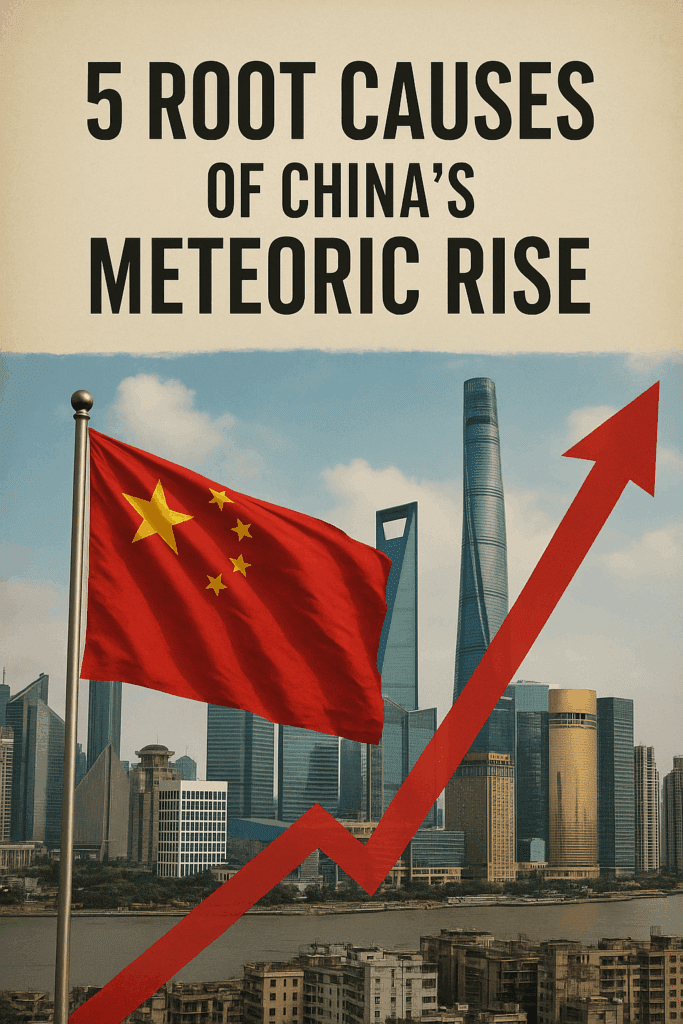
5 Root Causes of China’s Meteoric Rise
China’s transformation from a largely agricultural economy to the world’s second-largest economy represents one of the most remarkable success stories in modern economic history. Since opening up to foreign trade and implementing free-market reforms in 1979, China has maintained an average annual GDP growth rate of 9.5% through 2018, described by the World Bank as “the fastest sustained expansion by a major economy in history”. This extraordinary growth has enabled China to lift an estimated 800 million people out of poverty and become a dominant force in global manufacturing and trade.
1. Economic Reform Policies and Market Liberalization
The foundation of China’s meteoric rise lies in the comprehensive economic reforms initiated by Deng Xiaoping after 1978. These reforms represented a fundamental shift away from central planning toward market-oriented policies while maintaining political stability. The strategy combined gradualist reforms with pragmatic leadership, creating what became known as “socialism with Chinese characteristics”. Deng’s approach was characterized by “incentive compatibility” – designing reforms so that even potential losers benefited from the changes. This strategy co-opted bureaucrats by allowing them to sponsor semi-private businesses and convert their remaining political power into economic benefits. The military also benefited through this mechanism, ensuring broad support for the reform program. The reforms included decentralizing economic production, which led to substantial growth in household and corporate savings. Local and provincial governments gained authority to establish enterprises without central government interference, fostering a more market-oriented environment. This decentralization allowed local leaders to experiment with various privatization methods and compete to reduce regulations and barriers to investment. The success of these reforms was evident in China’s total factor productivity improvements, which accounted for 40.1% of GDP increases between 1978-2005, compared to a decline of 13.2% during the earlier Maoist period from 1957-1978. Agricultural reforms alone boosted production by 8.2% annually after implementation of the household responsibility system, compared with just 2.7% in the pre-reform period.
2. Strategic Infrastructure Development and Special Economic Zones
China’s establishment of Special Economic Zones (SEZs) beginning in 1979 created crucial testing grounds for market reforms and foreign investment attraction. The first four SEZs were established in Shenzhen, Zhuhai, Shantou (Guangdong province), and Xiamen (Fujian province), offering more liberal economic policies than the rest of the country. These zones functioned as economic laboratories where foreign and domestic trade could be conducted with tax incentives, reduced regulations, and streamlined procedures. The success was dramatic – Shenzhen’s population grew from approximately 30,000 in 1979 to over 1 million by the early 21st century. By 1984, the government expanded the concept to 14 additional open coastal cities. The SEZs attracted foreign direct investment by offering significant advantages including preferential tax rates, simplified regulations, and access to cheap labor. Foreign firms benefited from lower production costs and streamlined customs procedures, while China gained access to advanced technology, management expertise, and manufacturing capabilities. The infrastructure development extended beyond SEZs to massive nationwide investments. China’s Belt and Road Initiative, launched in 2013, has committed over $1 trillion to infrastructure projects globally. This initiative represents the continuation of China’s infrastructure-focused growth model, with cumulative BRI engagement reaching $1.175 trillion by 2024. The transport and energy infrastructure investments have been particularly significant. In 2024 alone, China’s BRI engagement included $9.6 billion in rail projects and $3.1 billion in road construction globally. This infrastructure development has supported both domestic economic integration and international trade expansion.
3. Foreign Direct Investment and Technology Transfer
Foreign Direct Investment became a critical driver of China’s economic transformation, contributing an estimated 3 percentage points to annual GDP growth during the 1990s. The impact extended beyond capital formation to include significant technology transfer and productivity improvements. Research shows that FDI contributed directly through capital deepening (0.4 percentage points annually) and indirectly through total factor productivity improvements (2.5 percentage points annually) during the 1990s. Foreign-funded enterprises generated positive spillover effects to other sectors, adding an estimated 2.2 percentage points to annual GDP growth. China’s policies to attract FDI were comprehensive and strategic. The government provided incentives including tax breaks, favorable regulatory environments, and access to low-cost labor through the SEZ system. Initially, FDI came predominantly from Hong Kong and diaspora communities, but later expanded to include major multinational corporations. The technology transfer mechanism worked through several channels. Joint ventures between foreign and domestic companies facilitated knowledge sharing and technological adaptation. While some criticized this as “forced technology transfer,” it enabled China to rapidly close the technological gap with developed economies. By 2023, China’s actual utilized FDI reached $163.3 billion, with high-tech industries accounting for significant portions of this investment. Manufacturing FDI reached $19.89 billion in the first half of 2024, representing 28.4% of total FDI and marking a 2.4 percentage point improvement from the previous year. The presence of foreign enterprises also generated substantial employment. Analysis shows that provinces with larger FDI inflows experienced faster GDP growth and productivity improvements. This created a virtuous cycle where economic growth attracted more investment, which further accelerated development.
4. Export-Oriented Manufacturing and WTO Accession
China’s accession to the World Trade Organization in December 2001 marked a pivotal moment in its economic development. WTO membership provided unprecedented access to global markets while requiring significant domestic reforms. The economic impact was substantial, with studies estimating welfare gains of $40.6 billion annually from WTO accession alone. The timing proved crucial for China’s manufacturing sector. Trade liberalization coincided with the elimination of textile and apparel quotas under the Multifiber Agreement, which had previously restricted China’s exports. This removal led to a 16.8% increase in total export volume, with textile and apparel exports leading the growth. China’s manufacturing transformation was dramatic and comprehensive. The country moved from producing basic textiles and agricultural products to sophisticated electronics, machinery, and telecommunications equipment. By 2004, China had become the world’s third-largest exporter, and the share of consumer electronics in exports grew substantially.
The manufacturing boom was supported by several competitive advantages. China offered abundant low-cost labor, with wages in 1978 representing only 3% of average U.S. wages. The government maintained policies that kept labor costs low relative to productivity until the late 1990s. Manufacturing also benefited from economies of scale and increasingly sophisticated supply chains. Processing trade played a crucial role in China’s export success. This system allowed duty-free imports of intermediate inputs for export production, enabling China to participate in global value chains and produce increasingly sophisticated products. The approach allowed China to move up the technology ladder while maintaining cost competitiveness. China’s manufacturing sector now produces almost a third of the world’s manufactured goods and has moved beyond low-wage sectors to include computers, pharmaceuticals, and automobiles. The sector benefits from one of the world’s largest domestic markets, immense manufacturing scale, and highly developed supply chains.
5. High Savings and Investment Rates
China maintained exceptionally high savings rates throughout its growth period, providing the capital foundation for massive infrastructure and industrial investments. When reforms began in 1979, domestic savings stood at 32% of GDP, but this figure continued climbing as economic reforms progressed. The high savings rate reflected contributions from three sectors: households, government, and enterprises. Chinese households maintained savings rates around 25% of disposable income since 2000. Government saving resulted from policies favoring government-financed investment over consumption. Enterprise savings increased dramatically as profitability improved, particularly in capital-intensive industries. China’s investment rates were among the world’s highest, reaching 46.6% of GDP in 2011 before moderating to 41.1% by 2023. This investment was heavily concentrated in the enterprise sector, which distinguished China from other countries and explained most cyclical variations in total investment. Enterprise capital formation peaked at 35.5% of GDP in 1993 and remained consistently high thereafter. The high investment rates were closely linked to China’s industrial structure. Investment tends to be higher in industry due to inherent capital intensity, and China maintained a higher share of industry in GDP than most countries. This industrial focus created higher earnings that, when retained as enterprise savings, funded further expansion.
The savings-investment relationship created a virtuous cycle. High domestic savings financed high investment levels without excessive reliance on foreign capital. Net external financing of enterprise investment constituted only about one-third of total enterprise investment, making the growth model relatively self-sustaining. This capital formation enabled rapid productivity improvements and technological advancement. The combination of high savings, strategic investment allocation, and productivity gains from technology transfer created the financial foundation for sustained high growth rates.China’s meteoric rise resulted from the strategic convergence of these five fundamental factors. Market-oriented reforms provided the institutional framework, while SEZs and infrastructure development created the physical foundation for growth. Foreign investment and technology transfer accelerated technological advancement and industrial sophistication. WTO accession and export-oriented manufacturing integrated China into global markets. Finally, high savings and investment rates provided the capital necessary to sustain this transformation. The success of this model enabled China to achieve unprecedented poverty reduction, with 800 million people lifted out of extreme poverty between 1978 and 2018. The country transformed from producing primarily agricultural products to becoming a global manufacturing powerhouse, now generating $3.7 trillion in real manufacturing value added – more than the US, South Korea, Germany, and UK combined. However, this growth model now faces challenges as China approaches middle-income status. The demographic dividend is ending, labor costs are rising, and the economy must transition toward consumption-driven growth and higher value-added production. Understanding the root causes of China’s rise provides crucial insights for other developing nations seeking to replicate similar success while highlighting the unique conditions that made China’s transformation possible.
